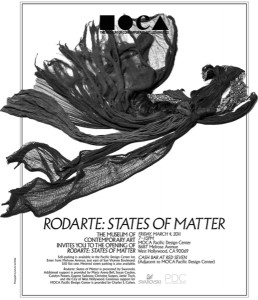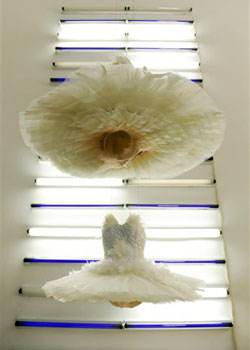Rodarte. States of Matter. March to May 2011. Installation. Museum of Contemporary Art Pacific Design Center, Los Angeles.
April Durham, 2011
The installation of the work of fashion and costume designers Laura and Kate Mulleavy (Rodarte) at MOCA-Pacific Design Center in West Hollywood represents a departure from the usual displays of fashion seen at fine art institutions in the recent past. Art world curatorial projects with fashion designers have resulted in an often-unsatisfying collision of designer labels within the institutionally separate but perhaps not so different (from the high-end shopping district) space of the museum. For example, the joint project between Marc Jacobs (Louis Vuitton) and Takashi Murakami for MOCA in 2007 resulted in a “product line” of wallpapers, handbags and day-minders that neither reinvented nor really disrupted the LV label, the Murakami oeuvre, or the curatorial habits of the museum. Because States of Matter is conceived as a hypertextual activation of synchronous and divergent narrative maps that link the “clothes,” the relationships among the collaborators, and the space of the museum and the city, this “fashion show” represents a significant reconsideration of the rendezvous between art contexts and fashion designs. Read more
usual displays of fashion seen at fine art institutions in the recent past. Art world curatorial projects with fashion designers have resulted in an often-unsatisfying collision of designer labels within the institutionally separate but perhaps not so different (from the high-end shopping district) space of the museum. For example, the joint project between Marc Jacobs (Louis Vuitton) and Takashi Murakami for MOCA in 2007 resulted in a “product line” of wallpapers, handbags and day-minders that neither reinvented nor really disrupted the LV label, the Murakami oeuvre, or the curatorial habits of the museum. Because States of Matter is conceived as a hypertextual activation of synchronous and divergent narrative maps that link the “clothes,” the relationships among the collaborators, and the space of the museum and the city, this “fashion show” represents a significant reconsideration of the rendezvous between art contexts and fashion designs. Read more
As we get the site organized, we’re starting to post short texts by members. We’re posting these under the “projects” menu, and as they grow in number, we’ll reconsider the best way of organizing them. We might grow topics and sub-topics, so, for instance, April’s first “project” is a review of a recent MOCA installation in Los Angeles, and later we might put this under “reviews.”
For now, we’ll just post these as project and see how they grow. They’re intended to be “first drafts” so comments for revisions and extensions are welcome!
The CDH has a new logo! However, it won’t last for long.
One of the most difficult tasks regarding web creation is encapsulating the look and feel of an entire website with a tiny square logo.
Some of these logos are as small as 16 X 16 pixels. Known as “favicons,” these 16X16 squares are the ones residing in the address bar of the web browser. In contrast, the icons for Apple’s touch interface on the iPhone and iPad are only slightly larger at 60 X 60 pixels.
A website’s header is also an important place for fostering a digital identity. While there is relatively more space within the top section of a website (perhaps as much as 250 X 900 pixels), there are always design limitations. Creating an image that is striking, but not obtrusive is difficult. A bright, eye-catching header can also take away from the impact of other content on the webpage.
With this in mind, the CDH’s new logo has been created as a starting point for further analysis–and further design. One of the workshops planned for this year is for each member of the CDH to create a new logo and header for the website. At the heart of this workshop will be the search for digital art. This is not necessarily art created through purely digital means, it’s more so art about the digital.
Workshop designs will not need to start in Adobe Photoshop, they can begin in whatever medium you wish. Feel free to paint, sketch, sculpt, or use whatever medium you feel best allows you to get at the art of the digital. At the workshop we can digitize these creations with cameras or scanners.
While most of the workshop creations can be fit into the confines of static pixels, those that cannot such as video or very large images, will still have a place on the website in the digital artwork portfolio.
Starting this fall, we’ve planned some workshops to help get at the “nuts and bolts” underpinning digital technology.
CDH members represent a wide variety of talent in digital technologies. While some CDH members might be digital novices, others are much more familiar with the components of social networking, blogs, websites, and so on.
Our goal with these workshops is to leverage the talent of existing members, and at the same time help others learn new skills. Each workshop will tackle a digital subject, but the workshops themselves will created by the group.
Some possible examples of workshops are:
- The Digital You: Your identity on the Web
- Let’s Get Digital: Making a blog, website, or digital space
- Tools of the Digital Trade: Zotero, Evernote, and Dropbox
- What’s in a [domain] name?: TLD’s and URL’s
If, for example, no one in the group felt they would benefit from “The Digital You,” we could skip that one and move on to another subject. If someone has a topic they would like to add, that’s wonderful! These workshops are meant to explore, and to help bring down technical boundaries that might prevent members from reaching their full potential.
Instead of listening to someone lecture about these subjects, these workshops will be hands-on, so be sure to bring your laptops or other devices (and power cords!). The workshop schedule will be decided by the participants, and the length of the workshops should be between 30 to 60 minutes.
When we discuss these workshops at the next CDH meeting, please consider signing up from both perspectives–you can request a subject you would like to learn and you can sign up for a topic to help lead the group.
If there’s a topic you would like to address, please add it in the comments section below.
(I) Neomedievalism and the Corporate; (II)Realms of Play, Regimes of Truth; (III) Medieval Video Game Festival Poster Session
Please consider submission of proposals for any of three sessions at the 47th International Congress on Medieval Studies (http://www.wmich.edu/medieval/congress/) at Western Michigan University in Kalamazoo, Michigan from May 10-13, 2012.
These sessions are all sponsored by Medieval Electronic Multimedia Organization (http://medievalelectronicmultimedia.org/); one of these sessions is being co-sponsored with Studies in Medievalism (http://www.medievalism.net/) and Medievally Speaking (http://studiesinmedievalism.blogspot.com/). Read more
Non-Textual Technologies
In the fall quarter CDH will consider the following questions about non-textual technologies. What have been the forms and effects of the digital essay since the mainstreaming of the World Wide Web? What are the critical potentials for digital essays that deploy textual, audiovisual, and interactive elements? How have scholars and activists turned social media sites such as YouTube to the interests of the critical essay? What constitutes a scholarly or critical use of music, digital video, animation, performance or social media such that an essayistic dimension comes to the foreground in an online setting? How does the inclusion of such elements extend or challenge the structural and analytical logics of the traditional academic essay?
Fan Cultures/Communities
For the winter quarter, the Critical Digital Humanities Research Collective will be examining the growing role of fandom and community in the production of digital media. The treatment of both traditional and aesthetic narratives surrounding popular media forms as communally owned and controlled is indicative within fan communities of a personal investment in those narratives that simultaneously relies upon and attempts to undermine the sanctity of “official narratives.”
The Digital Archive
Perhaps no other academic resource has seen greater reassessment in the digital age than archive and in the spring quarter we will look at how those changes are affecting scholarship. Jan-Christopher Horak, director of UCLA’s Film and Television Archive, calls “the move to digitality…a paradigm shift of monstrous proportions.” For scholars, the need for the traditional archive has not ceased, while new methods of digitizing, storing and searching archives have changed the way we do academic work. They have also raised new questions about the methods and priorities of digital archiving, exemplified by the debate surrounding the Google Books project. This shift has also raised questions about the effects that the loss of materiality have on scholarship.
We’re happy to announce that CDH has been awarded a Mellon Workshop Grant for the coming academic year.
This grant will allow us to present invited speakers on research topics relevant to our interests.
We’re currently planning events and are hoping members will help us organize events for each quarter.
Get in touch about organizing events this year. We’ll be announcing upcoming events on the site.
Welcome to the new Critical Digital Humanities website.
Over the summer months we’ve worked to upgrade our presence on the Web. The CDH website has a new URL (http://cdh.ucr.edu), but we’ve also retained the old website for the time being.


